Downwards movement has continued a little further as last analysis expected. For the short term, volume and On Balance Volume suggest the direction for Monday and possibly Tuesday as well.
Summary: Expect this downwards swing to continue to support, which is at about 1,310 to 1,305. Do not expect this downwards swing to move in a straight line, because that is not how price behaves within a consolidation. Look out for a bounce Monday and / or Tuesday, and then the continuation of downwards movement.
Only the most experienced of traders should attempt to trade when price is clearly consolidating as it currently is for Gold and GDX. The rest should either hedge or wait for a breakout and trade the next trend. Always use stops and invest only 1-5% of equity on any one trade.
New updates to this analysis are in bold.
Grand SuperCycle analysis is here.
Last in-depth historic analysis with monthly and several weekly charts is here, video is here.
There are multiple wave counts at this time at the weekly and monthly chart levels. In order to make this analysis manageable and accessible only two will be published on a daily basis, one bullish and one bearish. This does not mean the other possibilities may not be correct, only that publication of them all each day is too much to digest. At this stage, they do not diverge from the two possibilities below.
BULLISH ELLIOTT WAVE COUNT
FIRST WEEKLY CHART
Cycle wave b may be a single zigzag. Zigzags subdivide 5-3-5. Primary wave C must subdivide as a five wave structure and may be either an impulse or an ending diagonal. Overlapping at this stage indicates an ending diagonal.
Within an ending diagonal, all sub-waves must subdivide as zigzags. Intermediate wave (4) must overlap into intermediate wave (1) price territory. This diagonal is expanding: intermediate wave (3) is longer than intermediate wave (1) and intermediate wave (4) is longer than intermediate wave (2). Intermediate wave (5) must be longer than intermediate wave (3), so it must end above 1,398.41 where it would reach equality in length with intermediate wave (3).
Within the final zigzag of intermediate wave (5), minor wave B may not move beyond the start of minor wave A below 1,236.54.
Within the diagonal of primary wave C, each sub-wave is extending in price and so may also do so in time. Within each zigzag, minor wave B may exhibit alternation in structure and may show an increased duration.
Within intermediate wave (1), minor wave B was a triangle lasting 11 days. Within intermediate wave (2), minor wave B was a zigzag lasting 2 days. Within intermediate wave (3), minor wave B was a regular flat lasting 60 days. Within intermediate wave (4), minor wave B was a regular contracting triangle lasting 40 days. Within intermediate wave (5), minor wave B may be expected to be an expanded flat, combination or running triangle to exhibit some alternation in structure. It may last as long as 40 to 60 days. So far it has lasted 45 days (refer to daily chart) and the structure is incomplete.
At this stage, minor wave B may now be a combination or triangle. These two ideas are separated out in daily and hourly charts below.
This first weekly chart sees the upwards wave labelled primary wave A as a five wave structure. It must be acknowledged that this upwards wave looks better as a three than it does as a five. The fifth weekly chart below will consider the possibility that it was a three.
FIRST DAILY CHART – COMBINATION
Minor wave B may be a double combination. The first structure in the double may have been a regular flat correction labelled minute wave w.
The double is joined by a three in the opposite direction, a zigzag labelled minute wave x.
The second structure in the double may be a zigzag labelled minute wave y. It would most likely end about the same level as minute wave w, at about 1,303.08, so that the whole structure takes up time and moves price sideways. That is the purpose of double combinations.
Minute wave y as a zigzag should look like an obvious three wave structure at the daily chart level. For that to happen minuette wave (b) within it should show up as one or more green daily candlesticks or doji.
When minute wave y is a complete zigzag, then the probability of the combination being over would be very high. While double combinations are very common structures, triples are extremely rare.
While minute wave y may also be a flat correction, in my experience double flats are fairly rare.
Minute wave y may also be a triangle but the expected pathway at this stage would be the same as the triangle wave count below, so it will not be separated out. A triangle within a combination is also in my experience uncommon.
FIRST HOURLY CHART – COMBINATION
Both wave counts at the daily chart level today expect that a zigzag downwards is unfolding. Both will now see minuette wave (a) complete at Wednesday’s low. The size in terms of duration of the following upwards and sideways movement looks like a new wave, not part of the last wave down. This looks like minuette wave (b).
There are multiple structural options for minuette wave (b). The two hourly charts published today will consider two different possibilities. They both work in exactly the same way for both daily wave counts.
This first idea looks at minuette wave (b) as a possibly complete triangle. If minuette wave (b) is complete, then it would not have shown up on the daily chart as one or more green daily candlesticks or doji, so this would be less likely.
If minuette wave (b) is over, then a target should be calculated for minuette wave (c).
If minuette wave (b) continues further, then the target must be recalculated. Minuette wave (b) may not move beyond the start of minuette wave (a) above 1,356.01.
SECOND DAILY CHART – TRIANGLE
This alternate daily chart is identical to the first daily chart up to the high labelled minor wave A. Thereafter, it looks at a different structure for minor wave B.
Minor wave B may be an incomplete triangle, and within it minute wave a may have been a double zigzag. All remaining triangle sub-waves must be simple A-B-C structures, and three of the four remaining sub-waves must be simple zigzags. One remaining sub-wave may be a flat correction.
Minute wave b may be unfolding upwards as a single zigzag, and within it minuette wave (b) may not move beyond the start of minuette wave (a) below 1,303.08.
This alternate wave count expects weeks of choppy overlapping movement in an ever decreasing range.
Triangles normally adhere very well to their trend lines. The triangle trend lines are commonly tested within the triangle sub-waves. Minuette wave (b) within minute wave b may have found support at the a-c trend line, and this indicates where minute wave c may end.
Minute wave c of the triangle may not move beyond the end of minute wave a below 1,303.08.
Minute wave d of a contracting triangle may not move beyond the end of minute wave b above 1,356.12. Minute wave d of a barrier triangle should end about the same level as minute wave b; the triangle will remain valid as long as the b-d trend line remains essentially flat. In practice, this means minute wave d can end slightly above 1,356.12. This invalidation point is not black and white; it involves an area of subjectivity.
Contracting triangles are the most common type. Barrier triangles are not common, but nor are they rare.
At the daily chart level, for this wave count it would be extremely likely that the zigzag of minute wave c looks like a three wave structure. For that to happen minuette wave (b) within it needs to show up on the daily chart as one or more green daily candlesticks or doji.
SECOND HOURLY CHART – TRIANGLE
Minuette wave (b) may be an incomplete zigzag. Within the zigzag, subminuette waves a and b may be over. Subminuette wave c may move higher, to bring minuette wave (b) up to either the 0.382 or 0.618 Fibonacci ratios. Neither may be favoured.
This second hourly chart has support today from classic technical analysis.
BEARISH ELLIOTT WAVE COUNT
FIFTH WEEKLY CHART
There were five weekly charts published in the last historic analysis. This fifth weekly chart is the most immediately bearish wave count, so this is published as a bearish possibility.
This fifth weekly chart sees cycle wave b as a flat correction, and within it intermediate wave (B) may be a complete triple zigzag. This would indicate a regular flat as intermediate wave (B) is less than 1.05 the length of intermediate wave (A).
If cycle wave b is a flat correction, then within it primary wave B must retrace a minimum 0.9 length of primary wave A at 1,079.13 or below. The most common length of B waves within flats is from 1 to 1.38 times the length of the A wave. The target calculated would see primary wave B end within this range.
I have only seen two triple zigzags before during my 10 years of daily Elliott wave analysis. If this wave count turns out to be correct, this would be the third. The rarity of this structure is identified on the chart.
It is very difficult now at the daily chart level to see a five down followed by a corrective structure complete. This wave count has reduced in probability this week.
TECHNICAL ANALYSIS
WEEKLY CHART
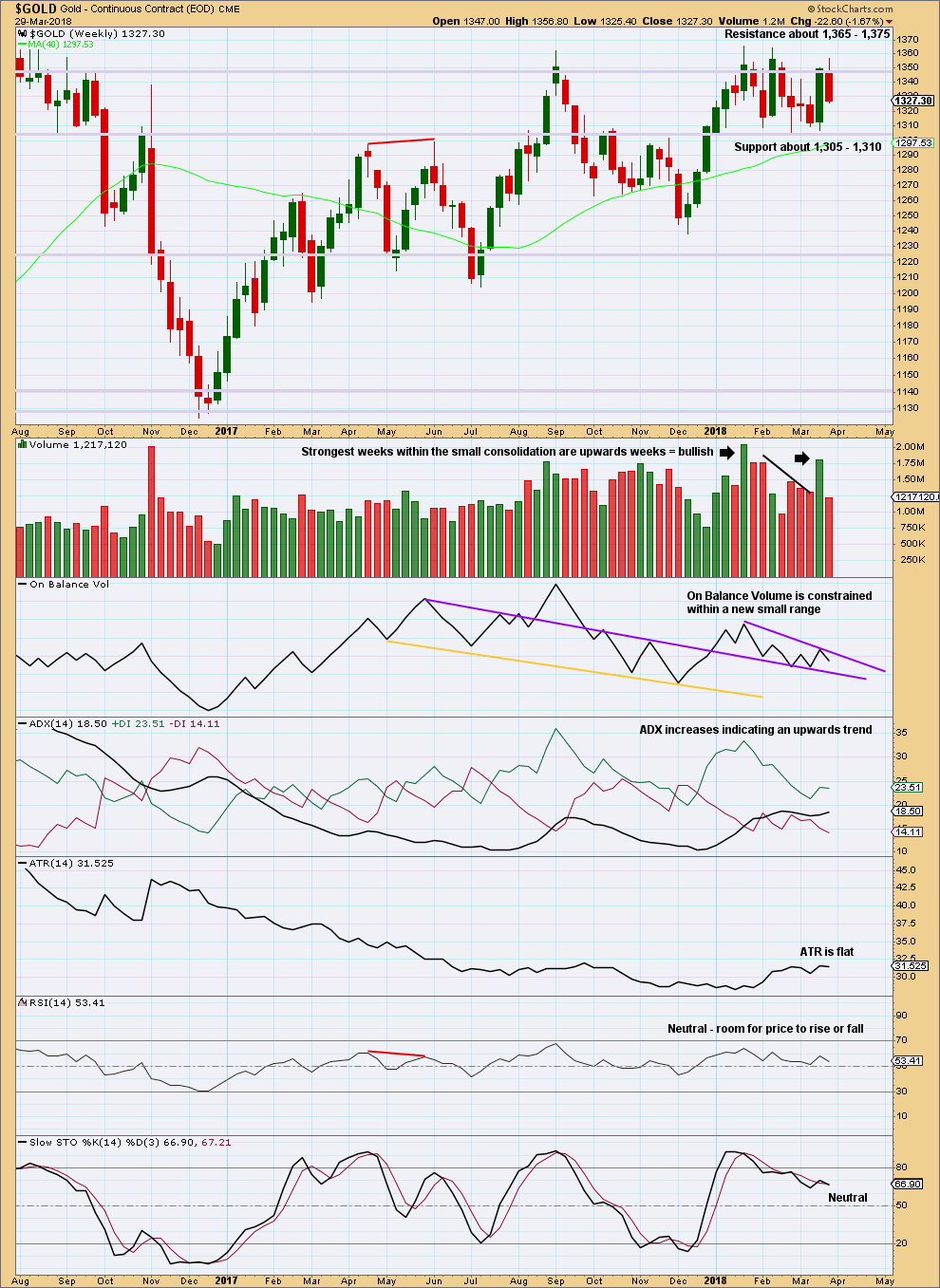
Click chart to enlarge. Chart courtesy of StockCharts.com.
A longer upper wick is bearish, but a lack of support from volume is slightly bullish. However, price can fall of its own weight. For downwards movement to be sustained for a little longer support from volume is not necessary.
A new resistance line is drawn on On Balance Volume this week.
DAILY CHART
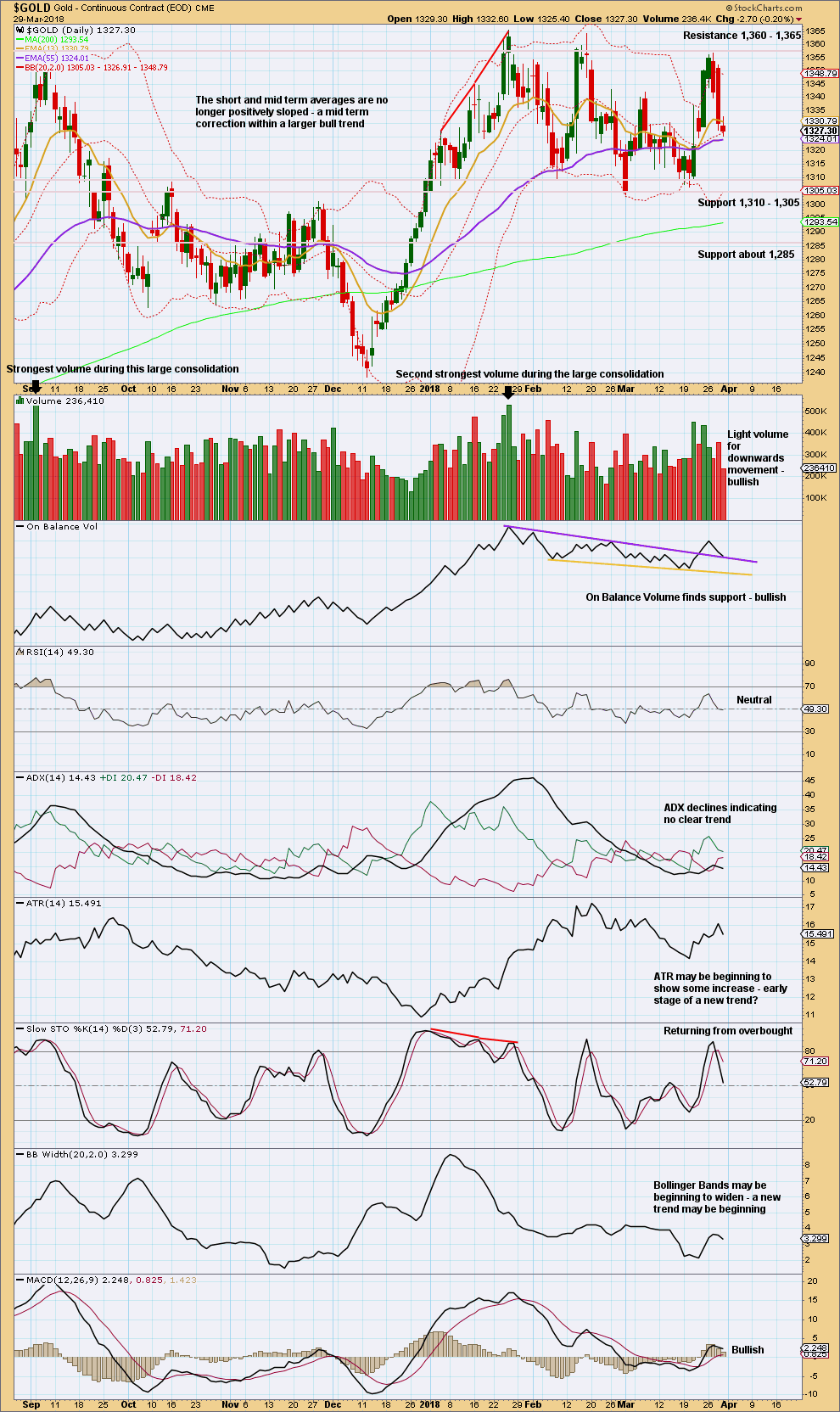
Click chart to enlarge. Chart courtesy of StockCharts.com.
Looking at the bigger picture, Gold has been within a large consolidation since about January 2017 (this chart does not show all of this large consolidation), and during this consolidation it is two upwards days that have strongest volume and an upwards week that has strongest volume. Volume suggests an upwards breakout may be more likely than downwards.
Currently, Gold is within a smaller consolidation that began in early January 2018. This consolidation is delineated by support about 1,310 to 1,305 and resistance about 1,360 – 1,365. It is an upwards day during this smaller consolidation that has strongest volume, suggesting an upwards breakout may be more likely here than downwards.
For the short term, a bounce may be expected here. On Balance Volume is at support and Thursday’s downwards movement lacks support from volume.
GDX WEEKLY CHART
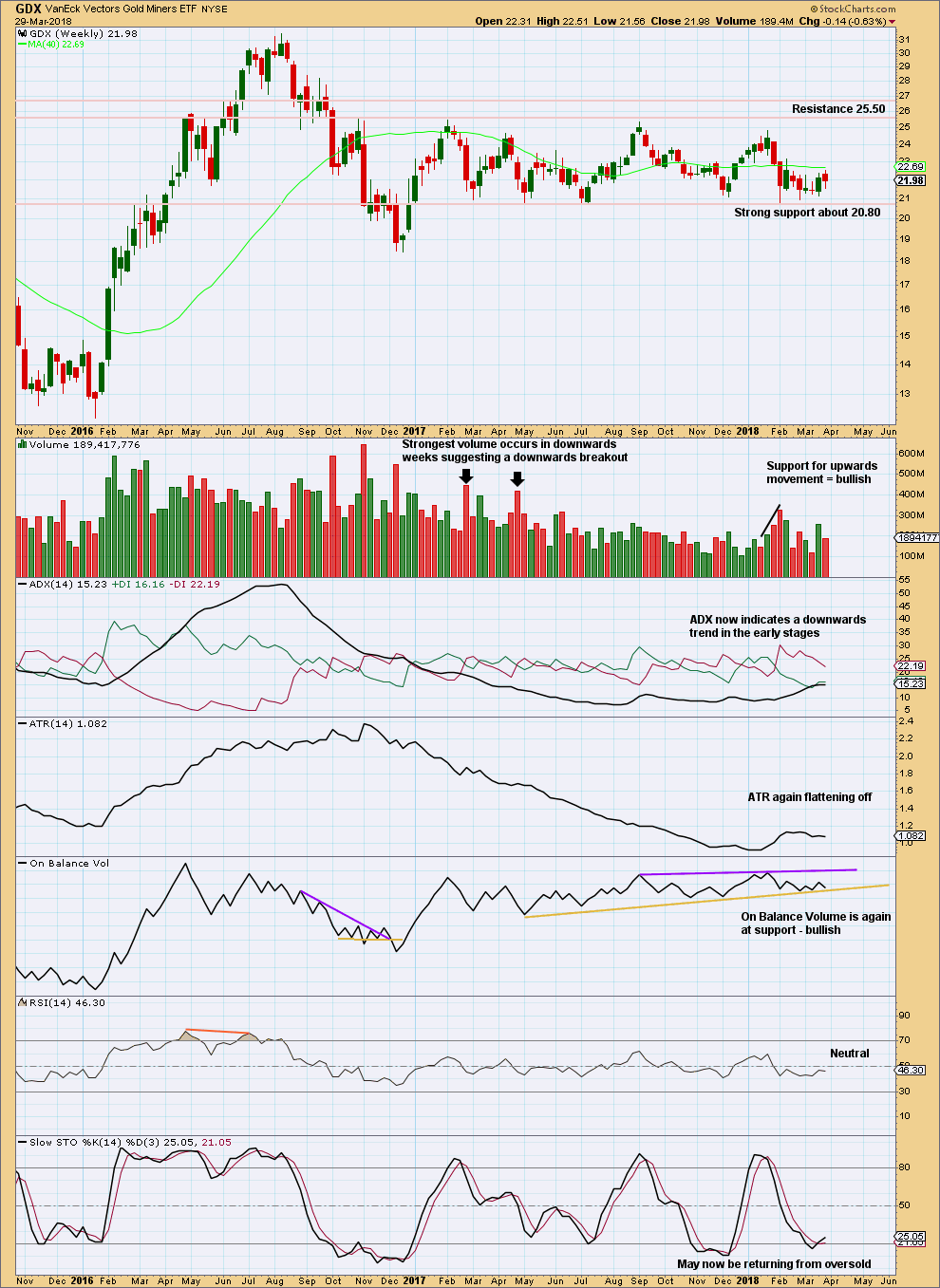
Click chart to enlarge. Chart courtesy of StockCharts.com.
Support about 20.80 has been tested about eight times and so far has held. The more often a support area is tested and holds, the more technical significance it has.
In the first instance, expect this area to continue to provide support. Only a strong downwards day, closing below support and preferably with some increase in volume, would constitute a downwards breakout from the consolidation that GDX has been in for a year now.
Resistance is about 25.50. Only a strong upwards day, closing above resistance and with support from volume, would constitute an upwards breakout.
With On Balance Volume again at support look for upwards movement next week. Downwards movement during this week lacks support from volume.
GDX DAILY CHART
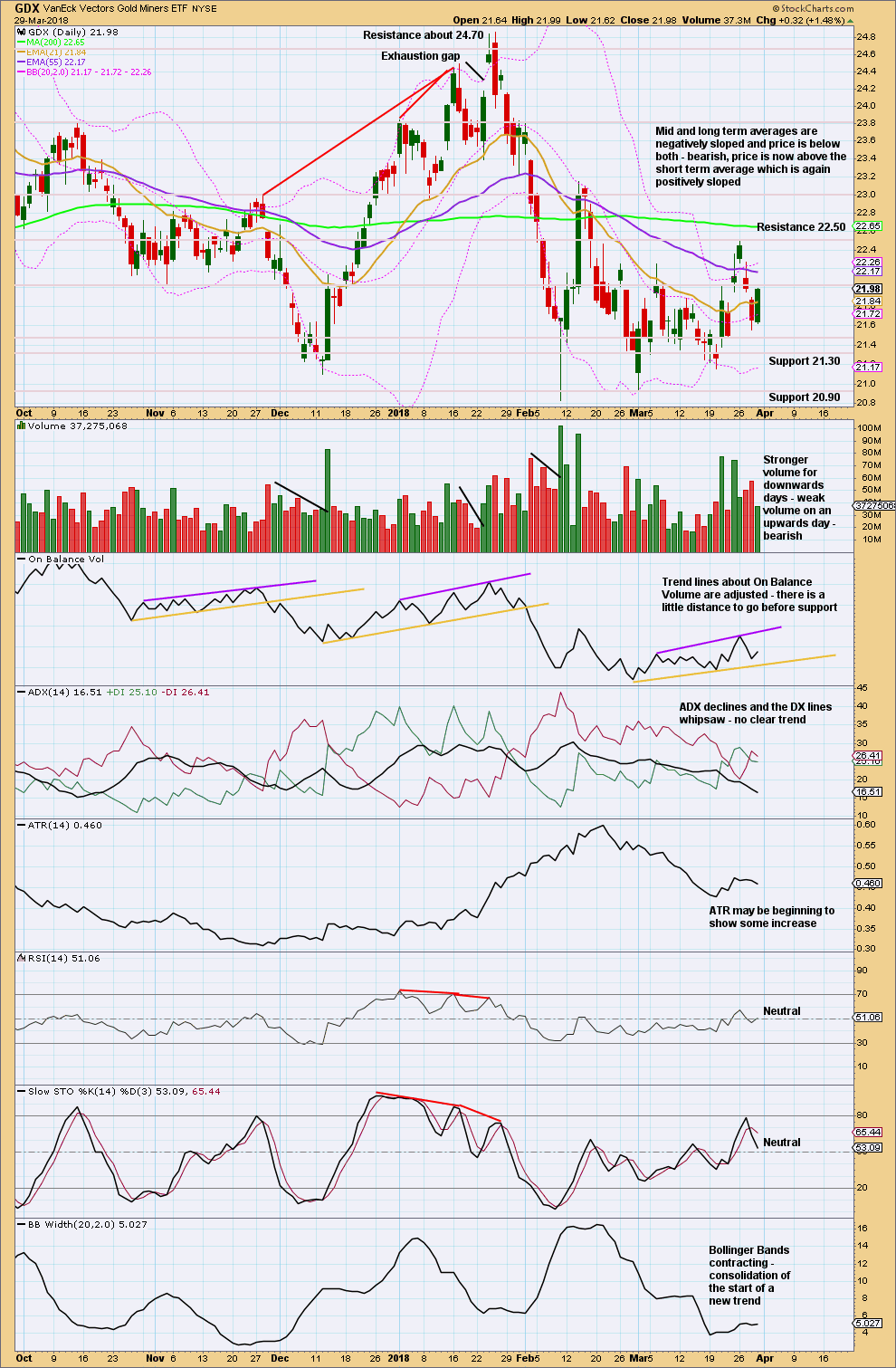
Click chart to enlarge. Chart courtesy of StockCharts.com.
GDX is range bound at both weekly and daily time frames. The smaller consolidation here has resistance now about 22.50 and support about 21.30 and 20.90.
During this consolidation, Stochastics is not reaching oversold and overbought. Look for a downwards swing to continue here until On Balance Volume finds support, price finds support, and Stochastics nears oversold (but may not reach it).
Published @ 11:58 p.m. EST.

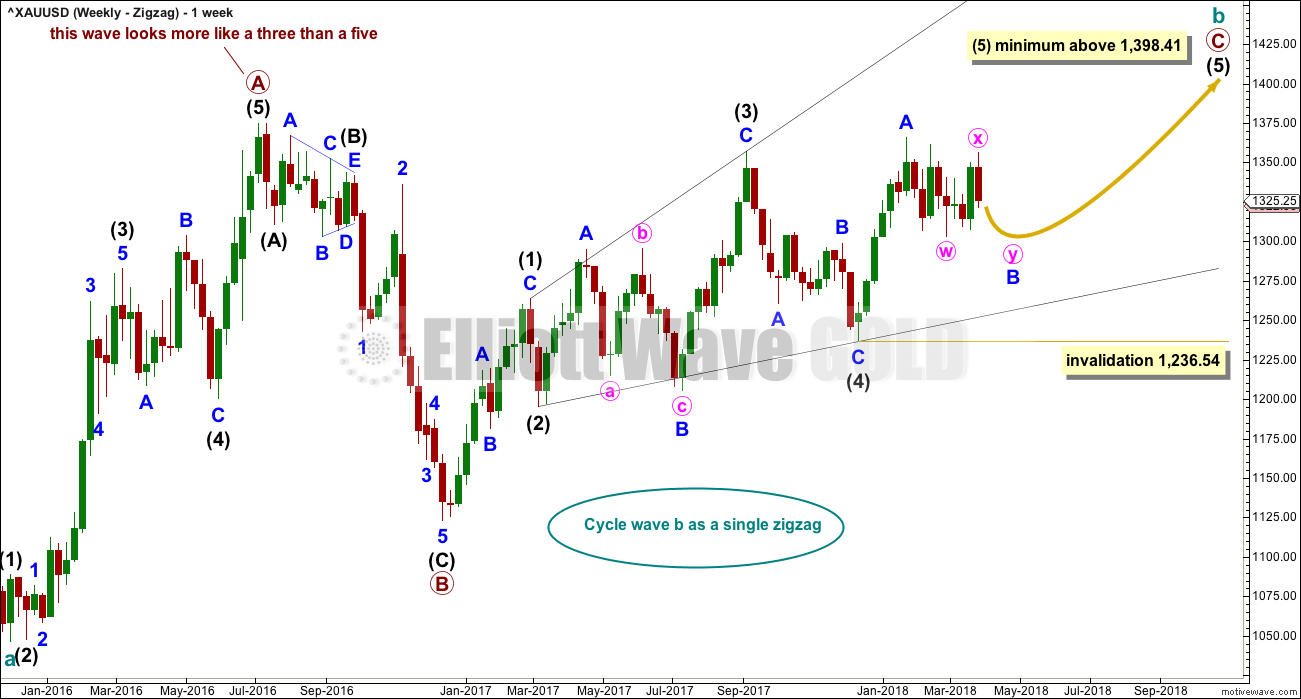
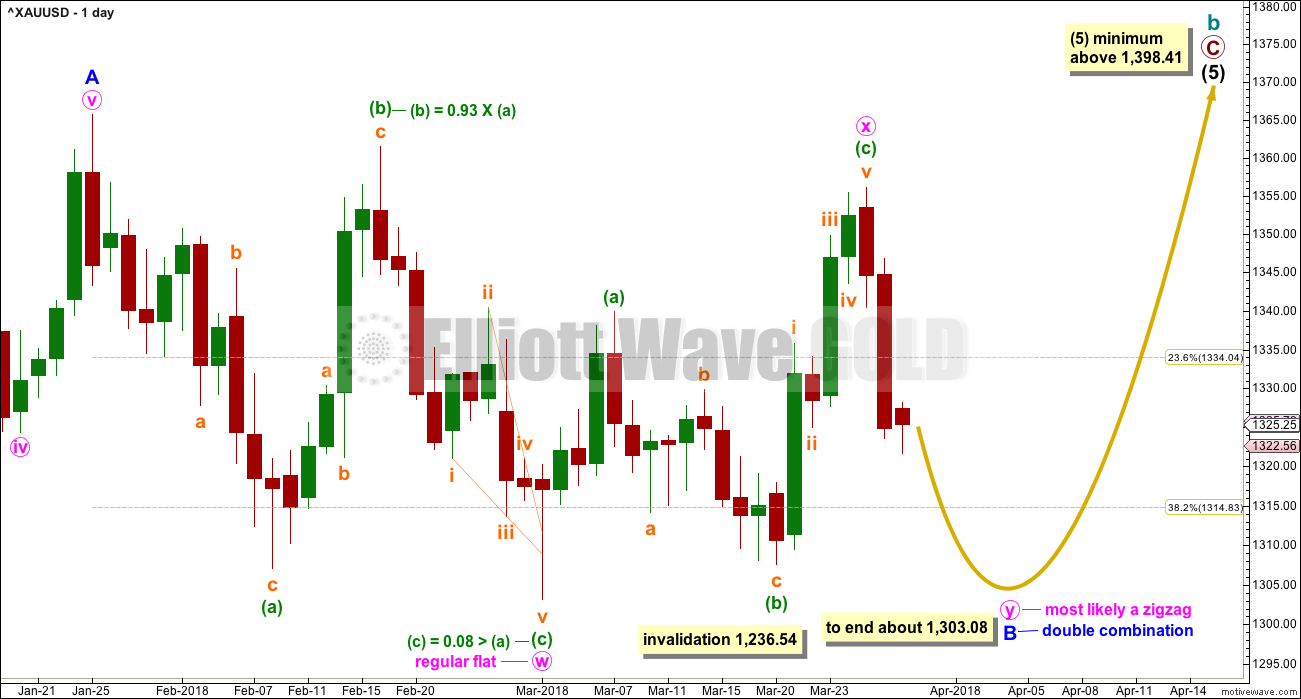

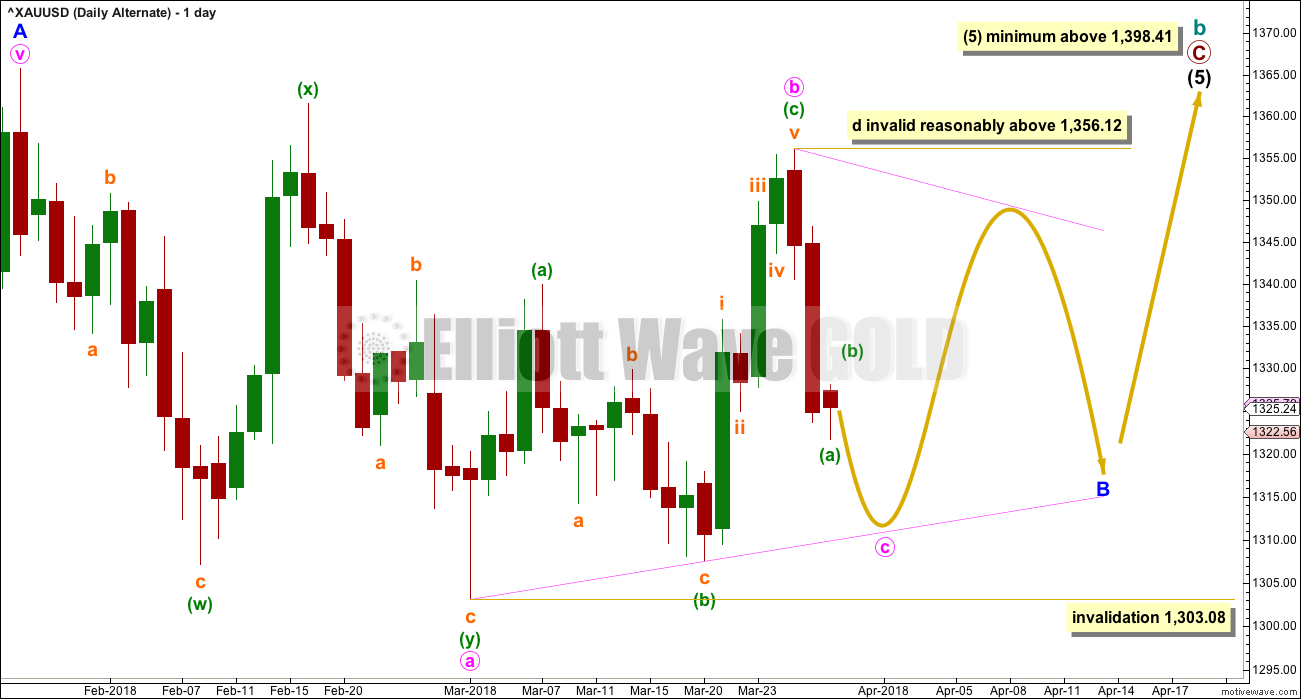
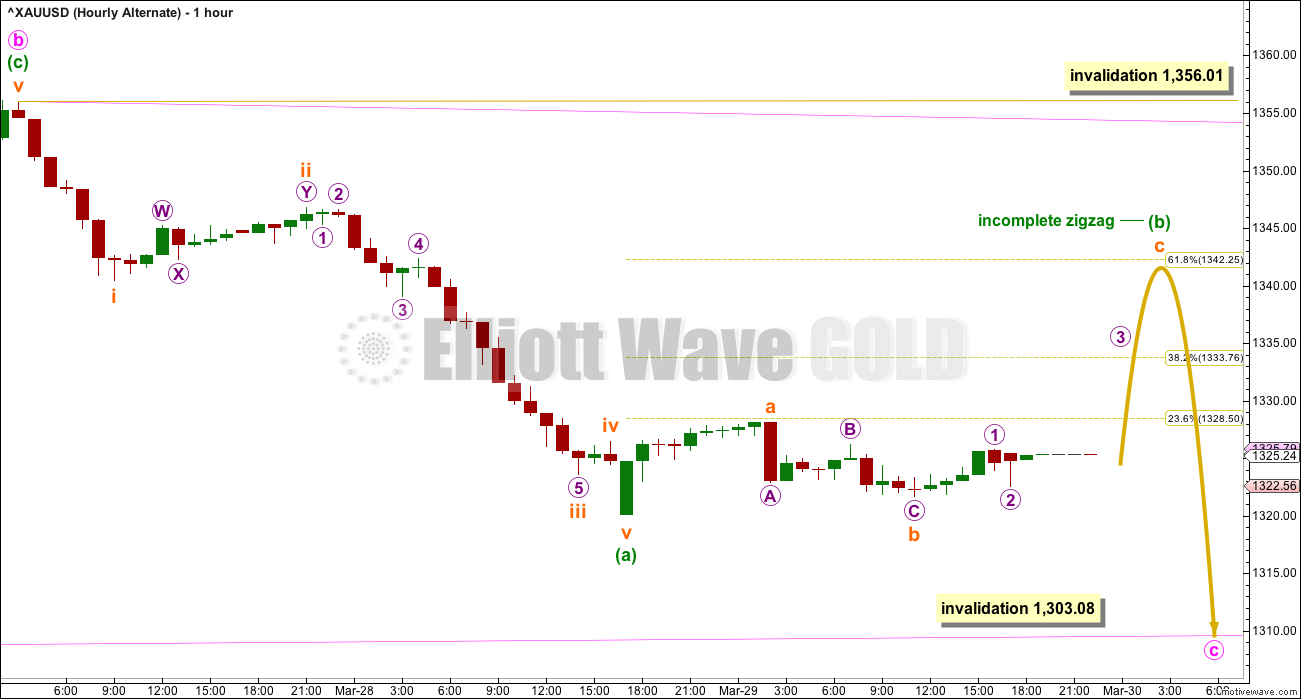
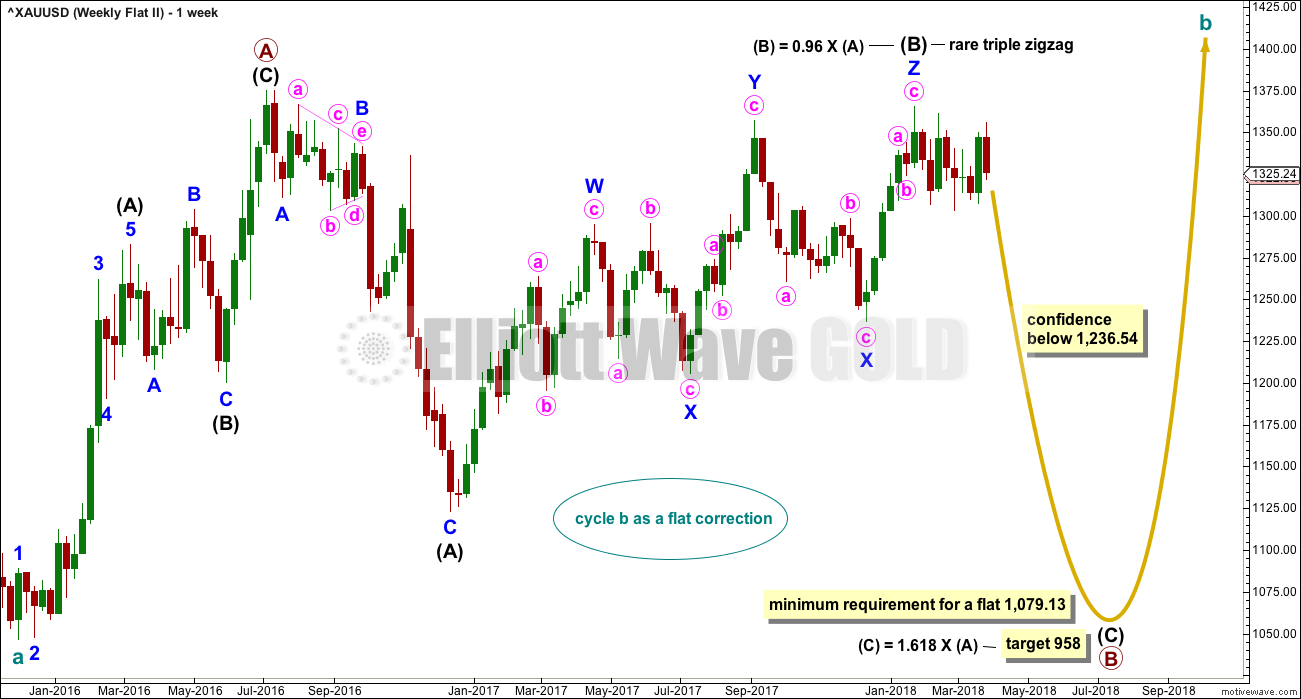
First daily chart updated, the combination for minor wave B idea:
Minute y is now looking like a possibly very obvious zigzag.
Triangle idea updated:
Minute c is now looking like a very obvious zigzag. Possibly.
So both these daily charts need to see a zigzag continue lower. The structure at the hourly chart level is the same.
Hourly chart for the two daily charts above:
If price breaks below support around 1,307ish, a H&S pattern may come into play and the correction may continue deeper.
Also, wave B of (5) will be equal in duration with wave B of (3) on 4/19.
Just a couple of ideas to watch for as we follow Lara’s updates for the main count.
Your video will be up shortly.
Regarding this weeks Oil analysis: I cannot currently connect to FXCM data. They often close access during the weekend. I’ll do it as soon as I can connect.
Happy Easter everybody!
NY is closed for Good Friday tomorrow so this is the end of week analysis (neither BarChart nor StockCharts will have any data for Friday).
I’ll be doing the video tomorrow.
This week is the last free publication of Lara’s Weekly. Next week the subscription will launch, but you’ve all already got access to 2/3 of that anyway.
We’ve had to push launch of Lara’s Weekly out one week due to family commitments.
Next weekend there will be one more publication free of Lara’s Weekly.